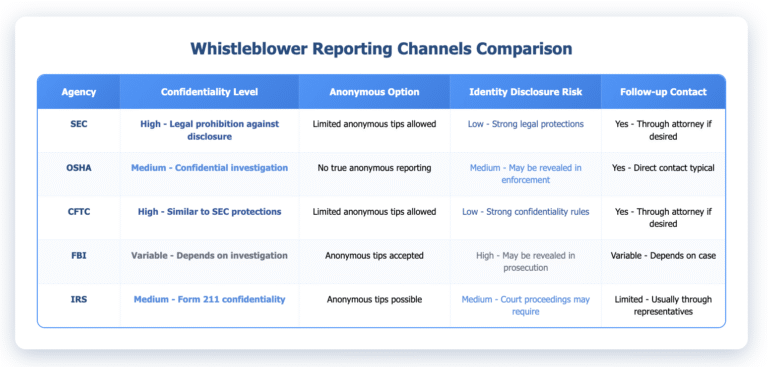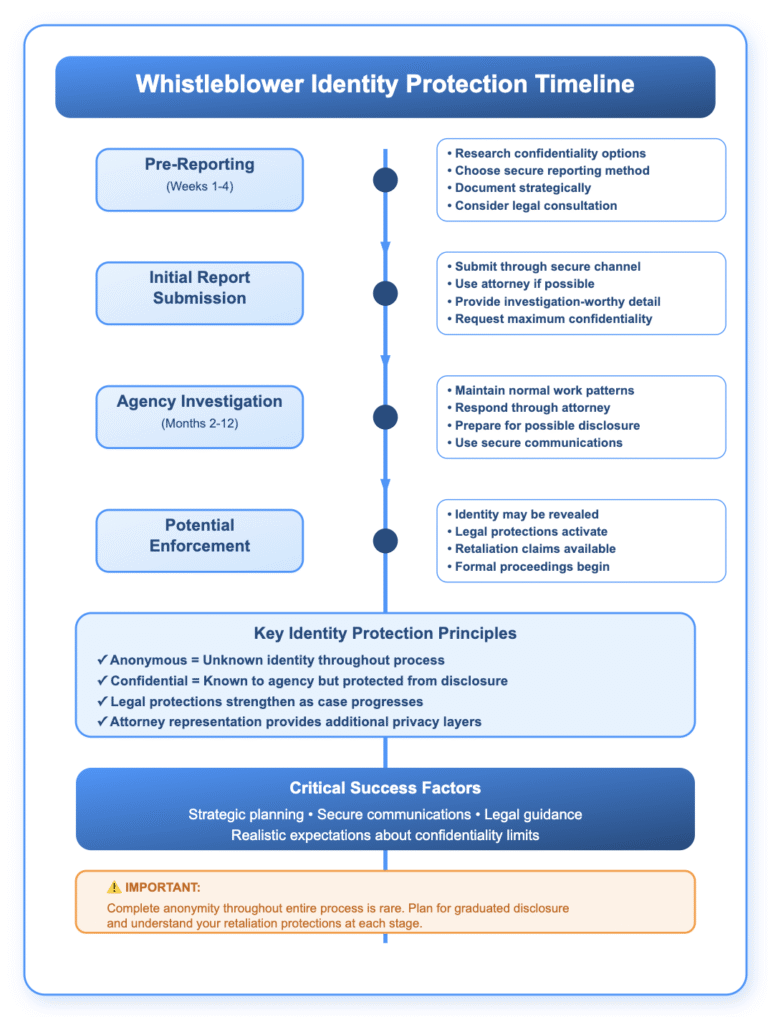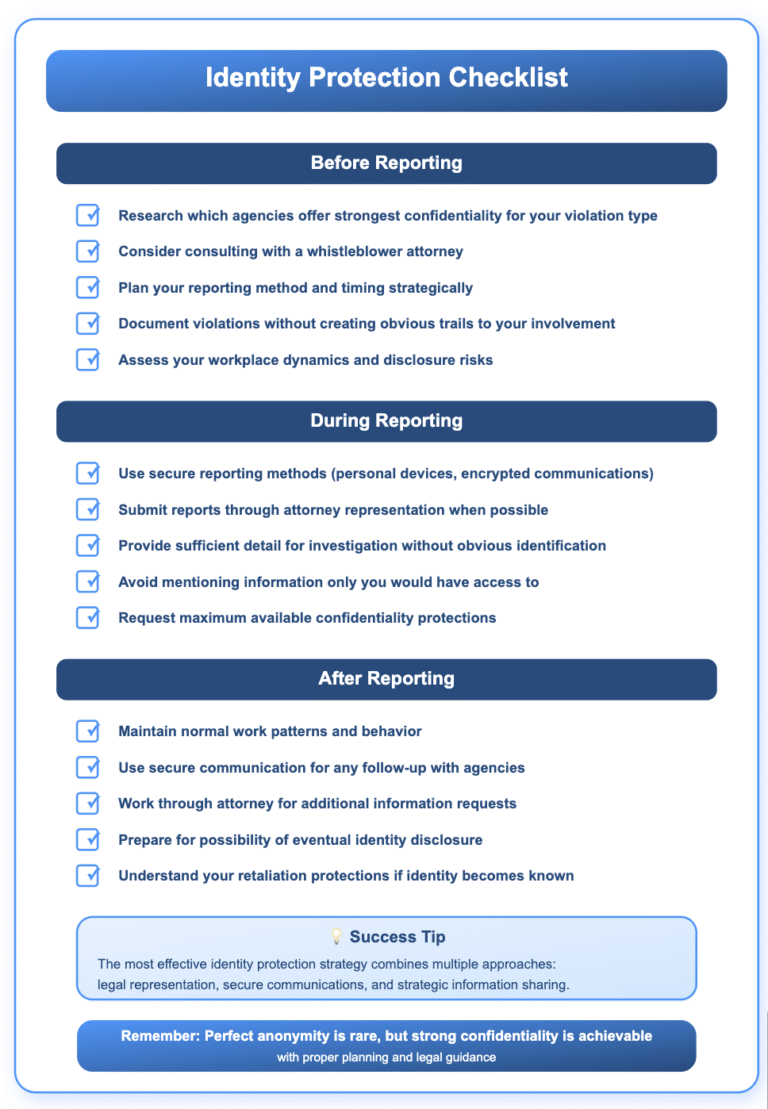When you’re considering reporting workplace violations, one of your biggest concerns is probably whether you can protect your identity. You want to do the right thing, but you also want to keep your job and avoid becoming a target for retaliation. The good news is that many whistleblower programs offer identity protection, but the reality is more nuanced than you might think.
This guide breaks down your options for anonymous and confidential reporting, explains the legal protections available, and helps you understand the realistic limitations you’ll face. You’ll learn when anonymity is possible, when it’s not, and how to maximize your protection throughout the reporting process.
Disclaimer: This article provides general information for informational purposes only and should not be considered a substitute for legal advice. It is essential to consult with an experienced employment lawyer at our law firm to discuss the specific facts of your case and understand your legal rights and options. This information does not create an attorney-client relationship.
Understanding the Difference: Anonymous vs. Confidential Reporting
Before diving into specific programs, you need to understand the critical difference between anonymous and confidential reporting. These terms are often used interchangeably, but they have distinct legal meanings that affect your protection level.
Anonymous reporting means your identity is completely unknown to the receiving agency or organization. You submit information without revealing who you are, and there’s no way to trace the report back to you. True anonymity is rare in formal whistleblower programs because agencies often need to contact reporters for follow-up information.
Confidential reporting means the agency knows your identity but keeps it protected from disclosure to others, including your employer. Your name appears in internal agency records, but it’s not shared publicly or with the organization you’re reporting. This is the more common form of identity protection in whistleblower programs.
The distinction matters because it affects what information you can provide, how agencies investigate your claims, and what protections apply to you throughout the process.
Federal Whistleblower Programs and Identity Protection
Different federal agencies offer varying levels of identity protection, and understanding these differences helps you choose the most appropriate reporting channel for your situation.
SEC Whistleblower Program: The Securities and Exchange Commission offers one of the strongest confidentiality protections in federal whistleblower programs. Under the Dodd-Frank Act, the SEC is prohibited from disclosing information that could reasonably be expected to reveal your identity without your consent.
You can submit tips through the SEC’s online portal or by mail, and your identity remains confidential throughout the investigation. The SEC won’t share your information with your employer or other parties without explicit permission, except in very limited circumstances involving court proceedings where disclosure becomes necessary.
OSHA Whistleblower Program: The Occupational Safety and Health Administration handles workplace safety and environmental violations under numerous federal statutes. OSHA investigates complaints confidentially, meaning they won’t reveal your identity to your employer without your permission during the initial investigation phase.
However, if your case proceeds to formal enforcement action, your identity may eventually become known. OSHA will consult with you before making any disclosure, but complete anonymity throughout the entire process isn’t guaranteed.
CFTC Whistleblower Program: The Commodity Futures Trading Commission operates similarly to the SEC, offering strong confidentiality protections for derivatives and commodities market violations. The CFTC keeps whistleblower identities confidential and has specific procedures to prevent inadvertent disclosure during investigations.

State Whistleblower Protections and Anonymity
State whistleblower laws vary significantly in their identity protection provisions. Some states offer robust confidentiality protections, while others provide minimal identity safeguards.
California’s Whistleblower Programs: California operates several whistleblower programs with different confidentiality standards. The state’s False Claims Act includes confidentiality provisions similar to federal programs, while workplace safety complaints through Cal/OSHA follow procedures comparable to federal OSHA investigations.
New York’s Approach: New York’s whistleblower statutes generally allow confidential reporting, but the state’s approach varies by the type of violation reported. Financial fraud reports often receive stronger confidentiality protections than workplace safety or discrimination complaints.
Limited State Anonymity: Most state programs focus on confidential rather than truly anonymous reporting. State agencies typically need to contact complainants for additional information, making complete anonymity impractical for thorough investigations.
Practical Steps for Maintaining Confidentiality
Protecting your identity during the reporting process requires strategic planning and careful execution. Even programs with strong confidentiality protections can inadvertently reveal your identity if you’re not careful.
Choose Your Reporting Method Carefully: Different reporting methods offer different levels of identity protection. Online portals often provide better anonymity than phone calls, which may be recorded or traced. Written reports submitted by mail can offer good protection if properly prepared.
Consider using a personal computer from your home rather than workplace systems, which may be monitored. If you’re reporting online, consider using a VPN or other privacy tools to protect your digital footprint.
Control Information Flow: The details you include in your report can inadvertently reveal your identity. Avoid mentioning specific meetings you attended, conversations you personally witnessed, or documents only you would have access to. Focus on information that multiple employees might reasonably know.
Be strategic about timing your reports. Submitting a complaint immediately after a specific incident might make it obvious who reported it. Sometimes, waiting a short period or combining multiple incidents can provide better coverage.
Use Attorney Representation: Many whistleblower programs allow you to submit reports through an attorney, which adds an additional layer of identity protection. The attorney-client privilege protects your communications, and agencies often communicate with attorneys rather than directly with whistleblowers.
Attorney representation is particularly valuable in programs like the SEC and CFTC, where legal counsel can handle all communications and even receive any potential awards on your behalf.
Identity Protection Timeline and Strategies
Successfully maintaining confidentiality requires planning at each stage of the whistleblower process, from initial consideration through potential resolution.
Pre-Reporting Phase (Weeks 1-4): Begin by researching which agencies offer the strongest confidentiality protections for your type of complaint. Document violations carefully, but avoid creating obvious patterns that could trace back to you. Consider consulting with a whistleblower attorney to understand your options.
Initial Reporting Phase (Weeks 4-8): Submit your complaint using the most secure method available. If possible, use attorney representation to create additional identity protection. Provide sufficient detail for investigation without including information that obviously points to you as the source.
Investigation Phase (Months 2-12): Maintain normal work patterns to avoid suspicion. If investigators need additional information, work through your attorney when possible. Be prepared for the possibility that your identity may need to be revealed if the case proceeds to enforcement action.
Resolution Phase (Variable Timeline): Understand that formal enforcement actions, court proceedings, or settlement negotiations may eventually require identity disclosure. Plan for this possibility and understand your rights and protections at each stage.
Whistleblower Identity Protection Timeline

Limitations of Anonymity and Confidentiality
While many programs offer identity protection, you need to understand the realistic limitations you’ll face. Complete anonymity throughout an entire whistleblower process is often impossible, and various circumstances can compromise your identity protection.
Investigation Requirements: Thorough investigations often require follow-up information that only the original reporter can provide. Agencies may need you to clarify details, provide additional documents, or explain complex situations. This ongoing involvement makes complete anonymity difficult to maintain.
Legal Proceedings: If your report leads to enforcement action, litigation, or administrative proceedings, your identity may become necessary for the case. Courts may require your testimony, and defense attorneys have the right to confront witnesses against their clients.
Small Workplace Dynamics: In smaller organizations or departments, the pool of potential whistleblowers may be so limited that your identity becomes obvious regardless of formal confidentiality protections. The nature of the information reported may clearly point to specific individuals with access to that information.
Document Discovery: Legal discovery processes in subsequent litigation may reveal documents or communications that inadvertently identify you as the source of the original complaint. Even well-intentioned confidentiality protections can’t always prevent this type of inadvertent disclosure.
Maximizing Your Identity Protection
Despite these limitations, you can take specific steps to maximize your identity protection throughout the whistleblower process.
Strategic Information Sharing: Share information that demonstrates wrongdoing without revealing your unique perspective or access. Focus on patterns observable by multiple employees rather than specific incidents only you witnessed. This approach provides investigators with actionable information while protecting your identity.
Documentation Best Practices: Create contemporaneous records of violations, but store them securely outside your workplace. Avoid using company systems or email accounts for any whistleblower-related documentation. Consider using encrypted storage or providing documents to your attorney for safekeeping.
Communication Security: Use secure communication methods when contacting agencies or attorneys about your complaint. Personal email accounts, encrypted messaging apps, or secure online portals provide better protection than workplace phones or computers.
Legal Representation Benefits: Attorney representation provides multiple layers of protection. Attorney-client privilege protects your communications, attorneys can handle agency interactions on your behalf, and legal counsel can help you navigate decisions about identity disclosure as your case progresses.
Identity Protection Checklist
Use this checklist to maximize your confidentiality protection:

When Anonymity Isn't Possible
Some situations inherently make anonymity impossible, and recognizing these circumstances helps you make informed decisions about reporting.
Unique Access Information: If the wrongdoing you’re reporting involves information only available to a very limited number of people, maintaining anonymity becomes extremely difficult. Financial irregularities known only to accounting staff, executive-level decisions shared with few people, or technical violations observed only by specialists create natural limits on anonymity.
Required Personal Testimony: Some violations can only be proven through personal testimony about what you witnessed, heard, or experienced directly. Discrimination, harassment, or retaliation cases often require victim or witness testimony that makes anonymity impossible while still pursuing the claim effectively.
Court Proceedings: If your report leads to criminal charges or civil litigation, your identity will likely become known during legal proceedings. The Sixth Amendment guarantees defendants the right to confront witnesses against them, which limits anonymity in criminal cases involving your testimony.
Retaliation Protections When Identity Is Revealed
Understanding your legal protections if your identity becomes known helps you make informed decisions about reporting violations.
Federal Anti-Retaliation Laws: Most federal whistleblower statutes include strong anti-retaliation provisions that activate once your protected activity becomes known to your employer. The Sarbanes-Oxley Act, Dodd-Frank Act, and numerous environmental and safety statutes prohibit retaliation against employees who report violations.
These protections typically cover adverse employment actions, including termination, demotion, harassment, or other unfavorable treatment. You can file complaints with relevant agencies and may have rights to reinstatement, back pay, and other remedies if retaliation occurs.
State Law Protections: State whistleblower laws often provide additional retaliation protections beyond federal statutes. Some states have broader definitions of protected activity or longer limitation periods for filing retaliation claims.
Timing Considerations: Anti-retaliation protections generally begin when your employer learns of your protected activity. This creates a timing issue where you’re most vulnerable to retaliation during the period between your report and when these protections fully activate.
Moving Forward with Identity Protection
Deciding whether to report violations while protecting your identity requires balancing multiple factors: the seriousness of the wrongdoing, the strength of available confidentiality protections, your workplace situation, and your personal risk tolerance.
Remember that identity protection isn’t an all-or-nothing proposition. Many successful whistleblower cases involve graduated disclosure, where identity remains protected during initial investigation phases but may be revealed later if formal action becomes necessary.
The key is understanding your options, choosing the strongest available protections, and having realistic expectations about what confidentiality can and cannot provide throughout the process.
Take Action with Informed Confidence
Protecting your identity while reporting workplace wrongdoing requires careful strategy and legal knowledge. The decision to blow the whistle shouldn’t be made alone, especially when your career and financial security are at stake.
At Nisar Law, we understand the complexities of whistleblower identity protection and can help you navigate these challenging decisions. Our experienced employment attorneys can evaluate your situation, explain your confidentiality options, and help you develop a strategy that maximizes your protection while ensuring violations are properly reported.
Contact us for a confidential consultation to discuss your specific circumstances and learn how to protect your rights while holding wrongdoers accountable. Your identity protection starts with informed legal guidance.


